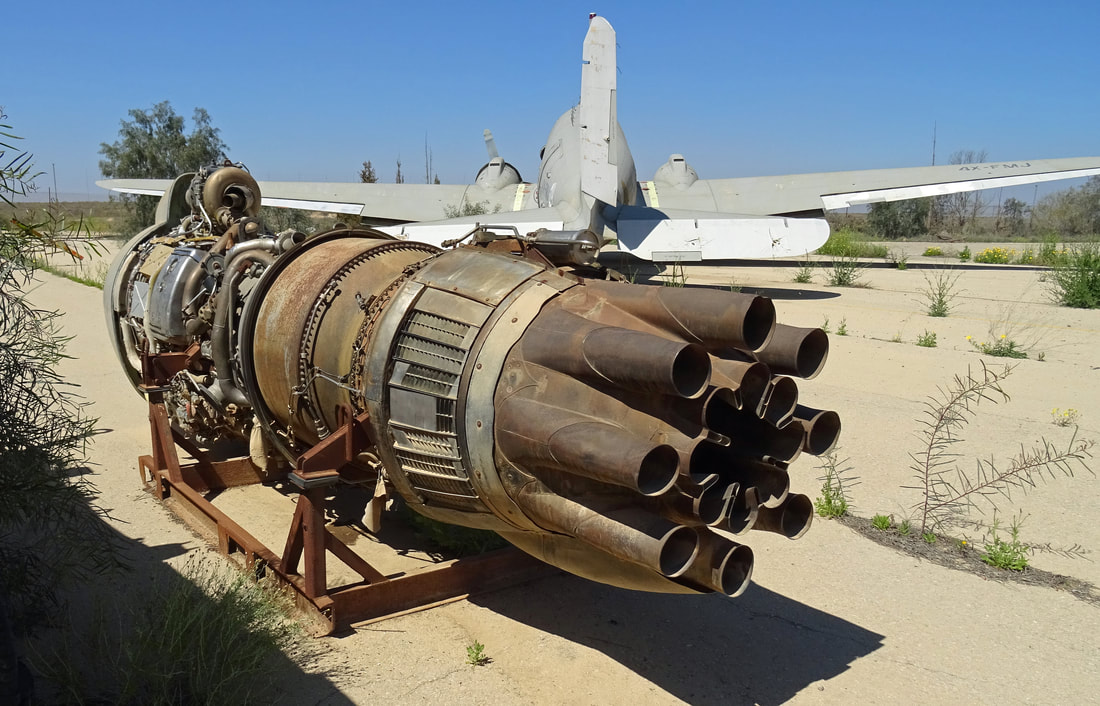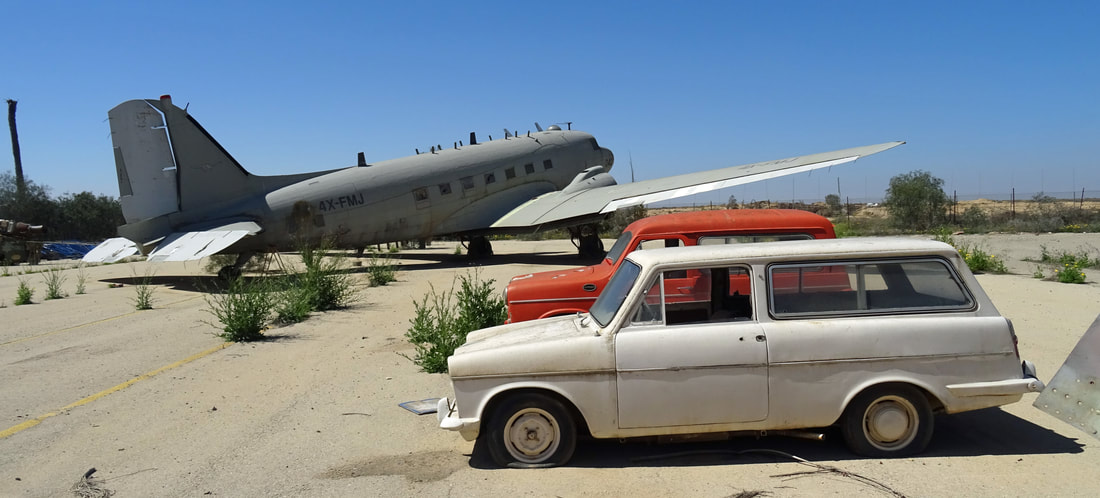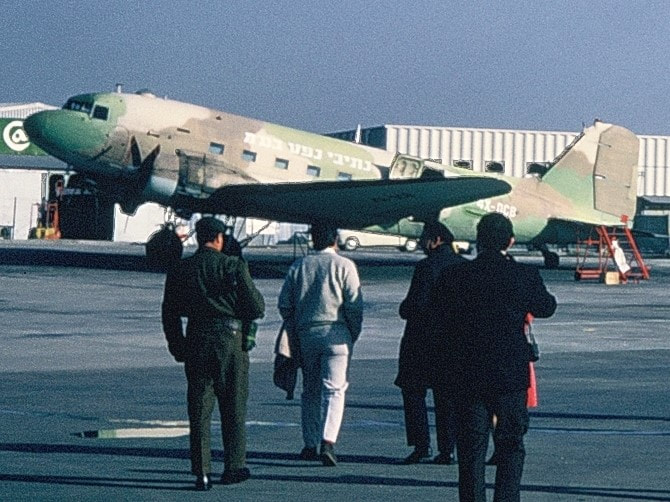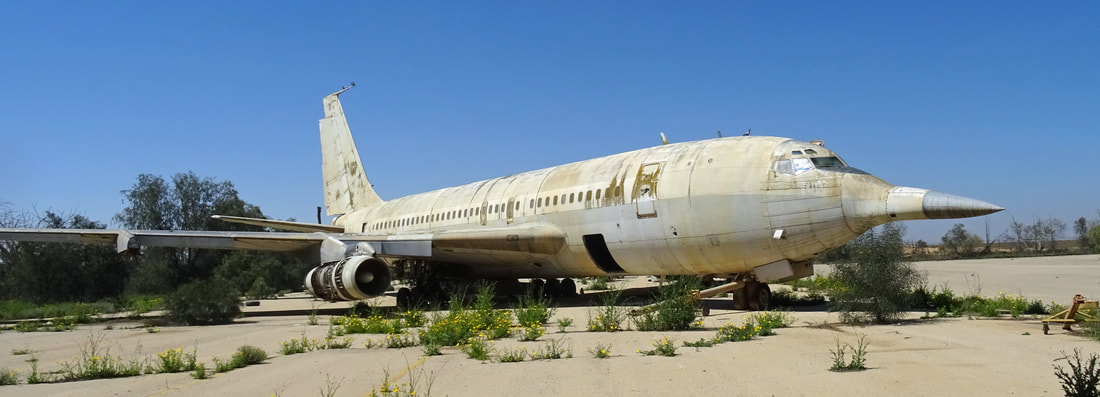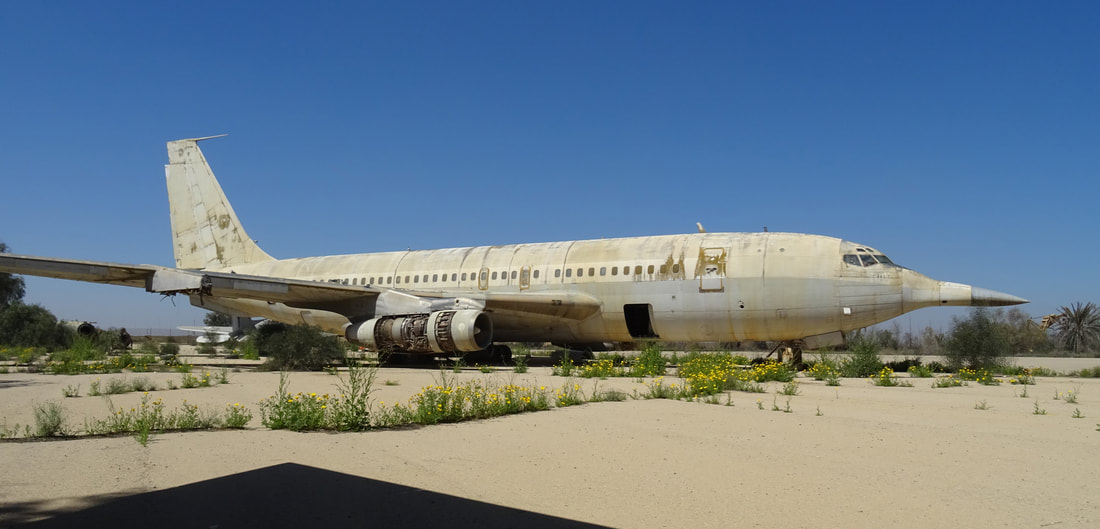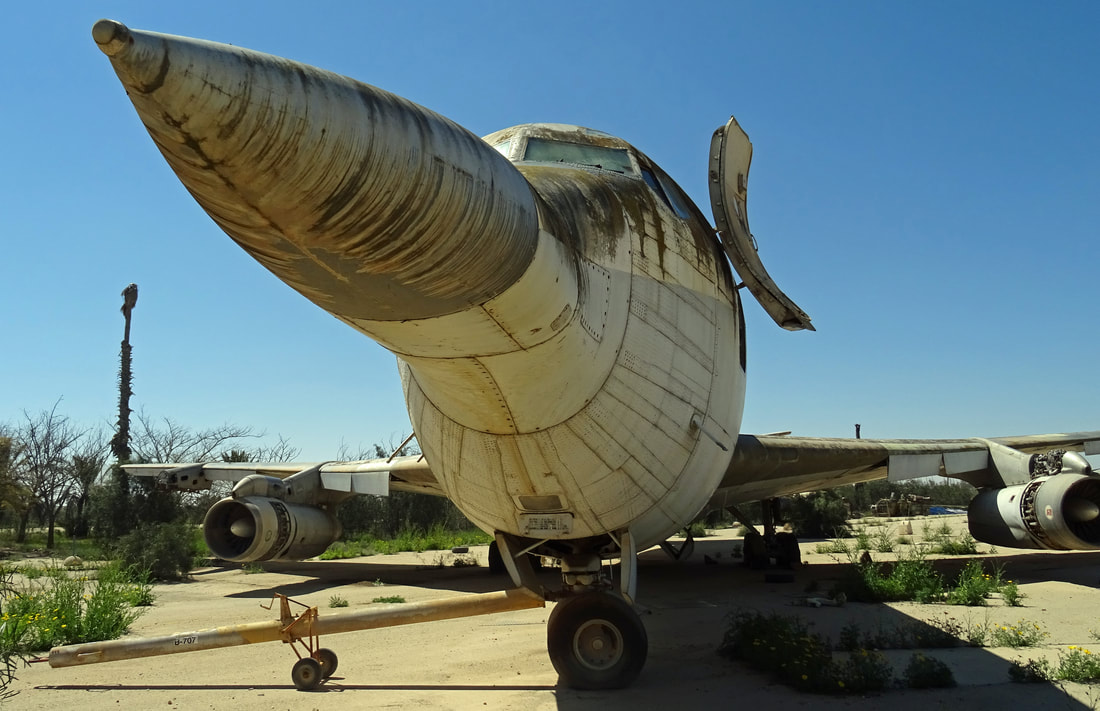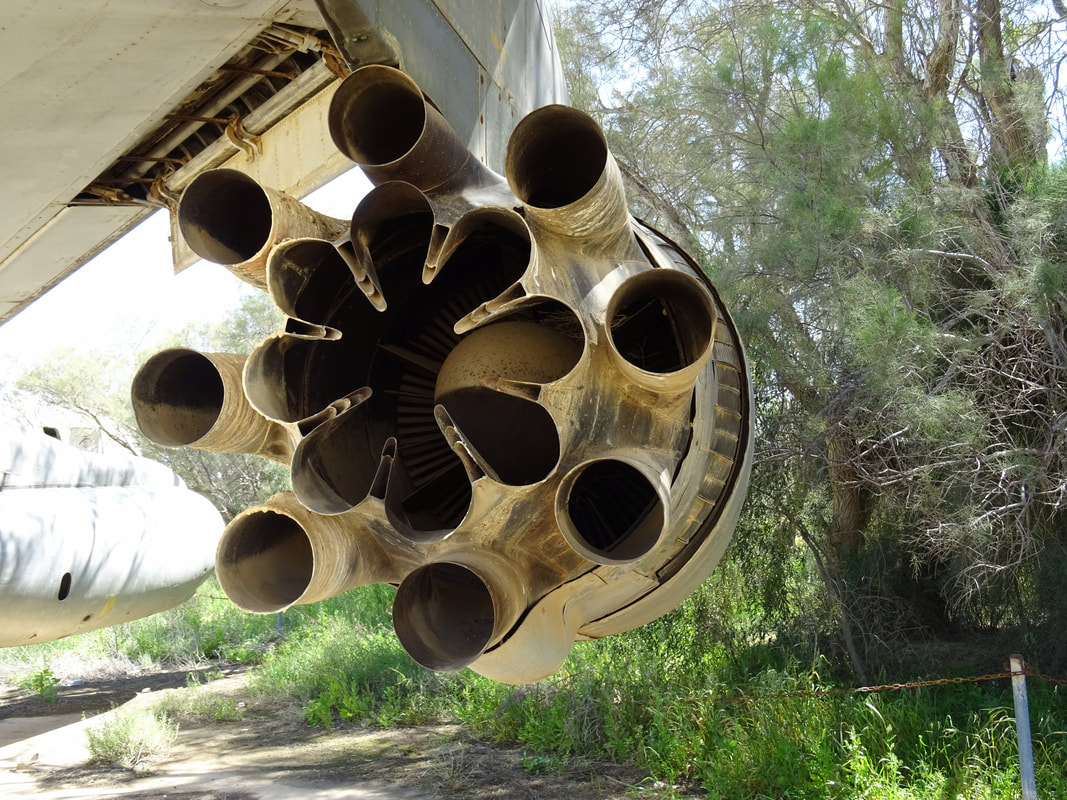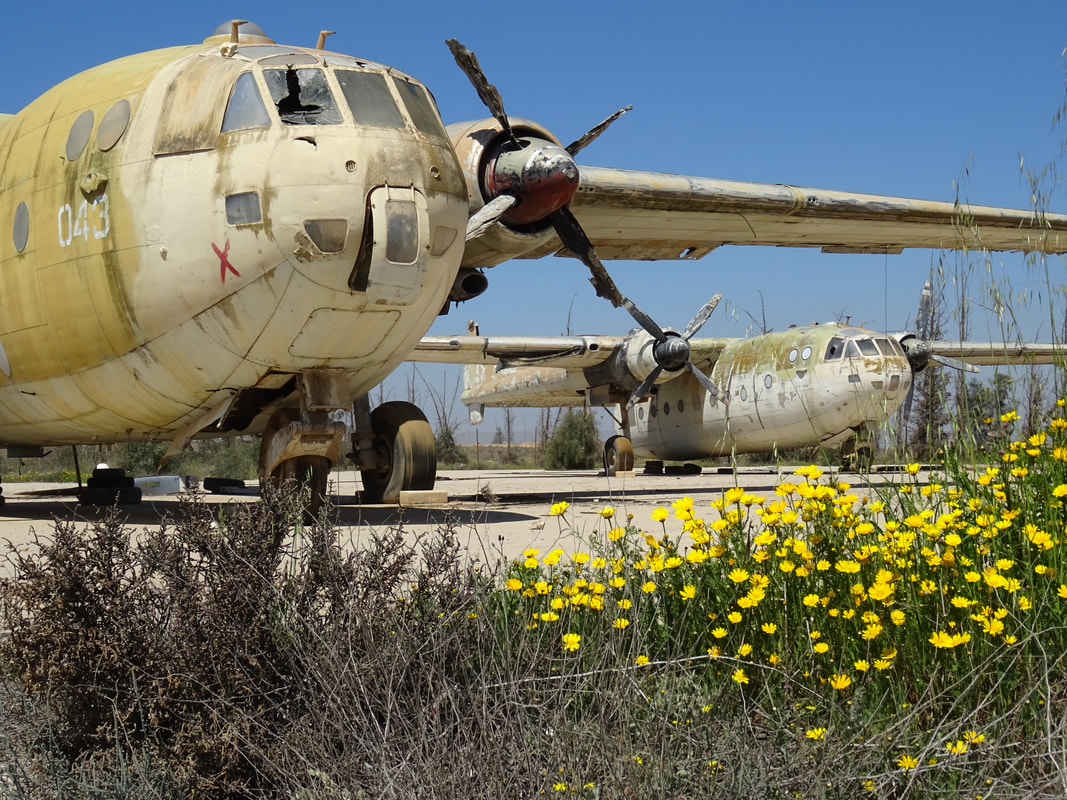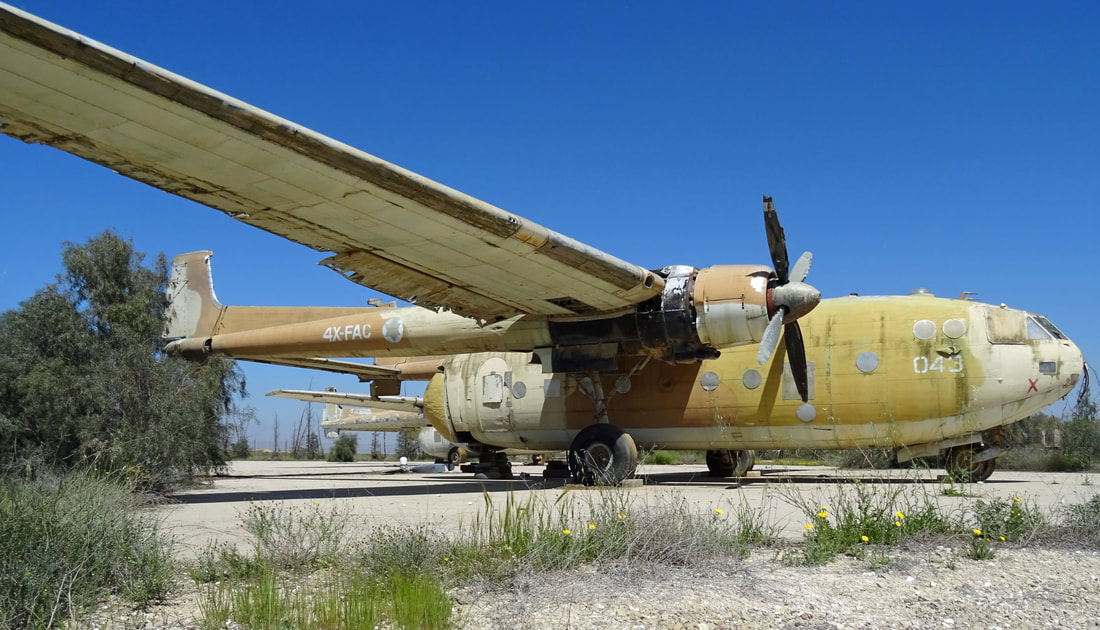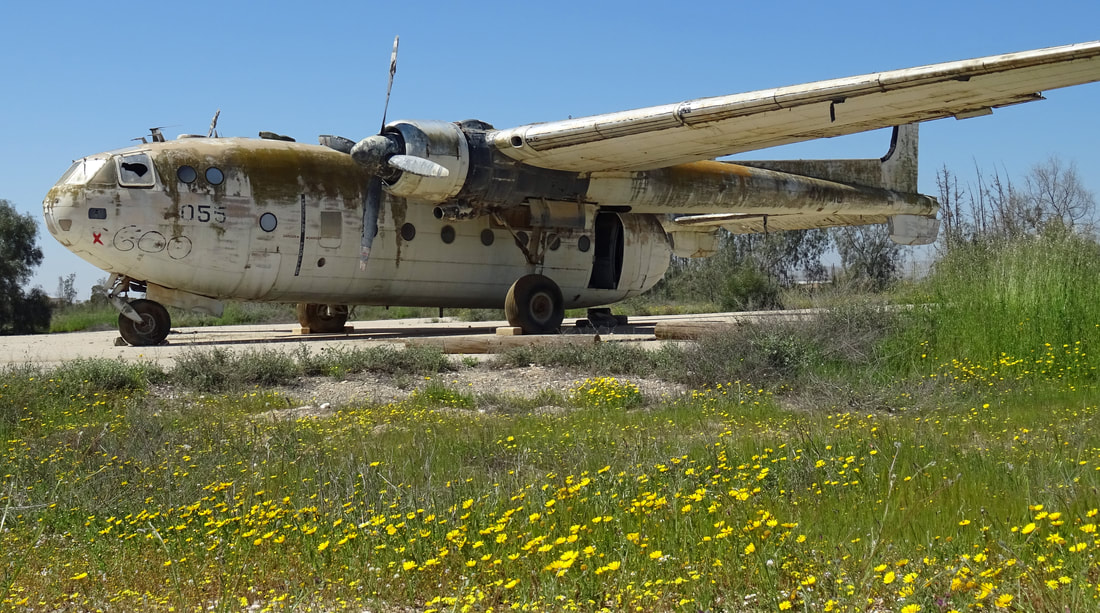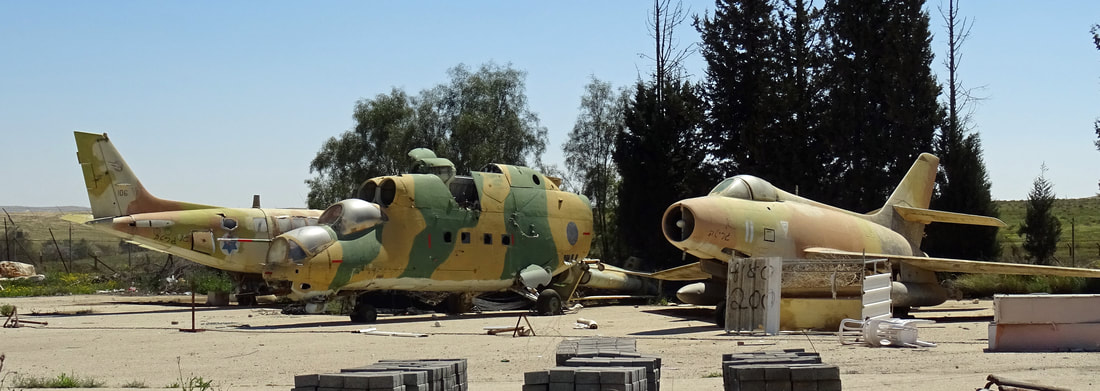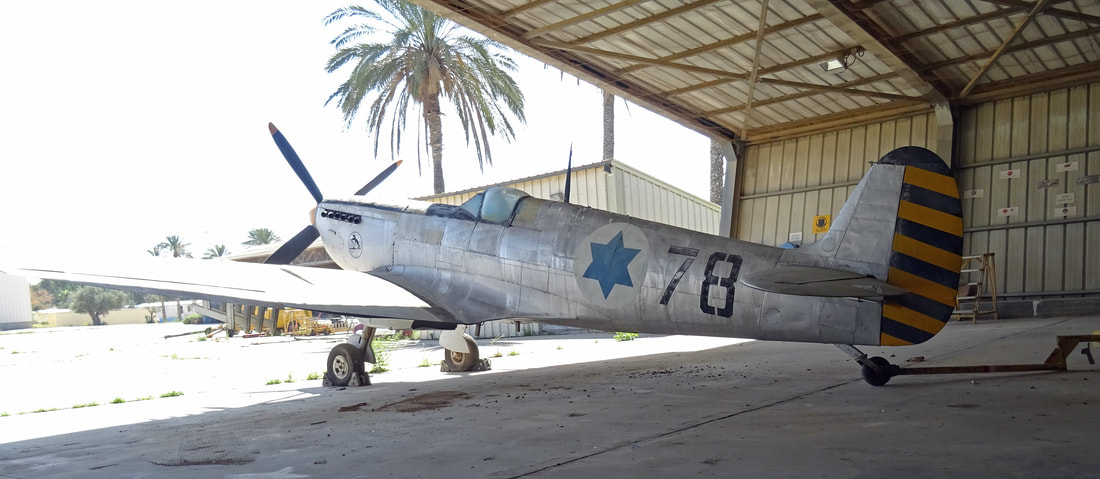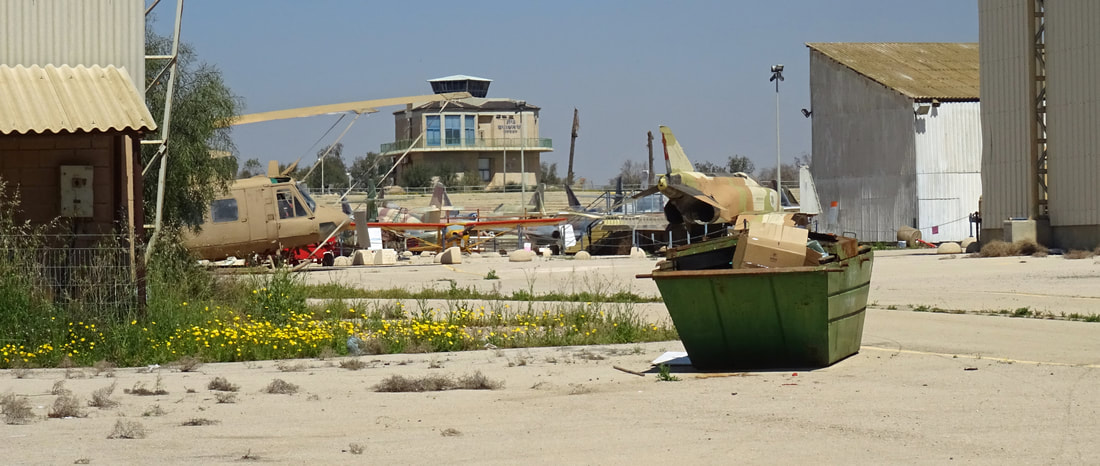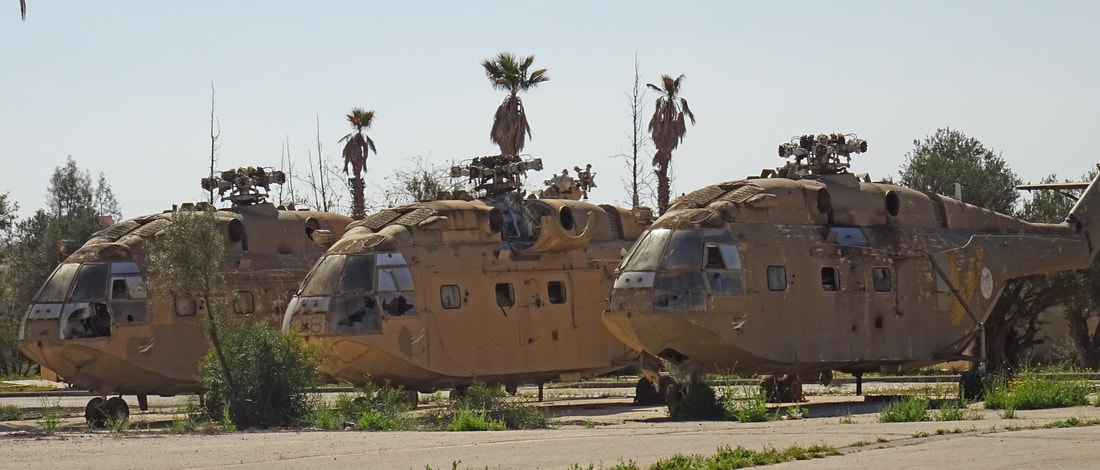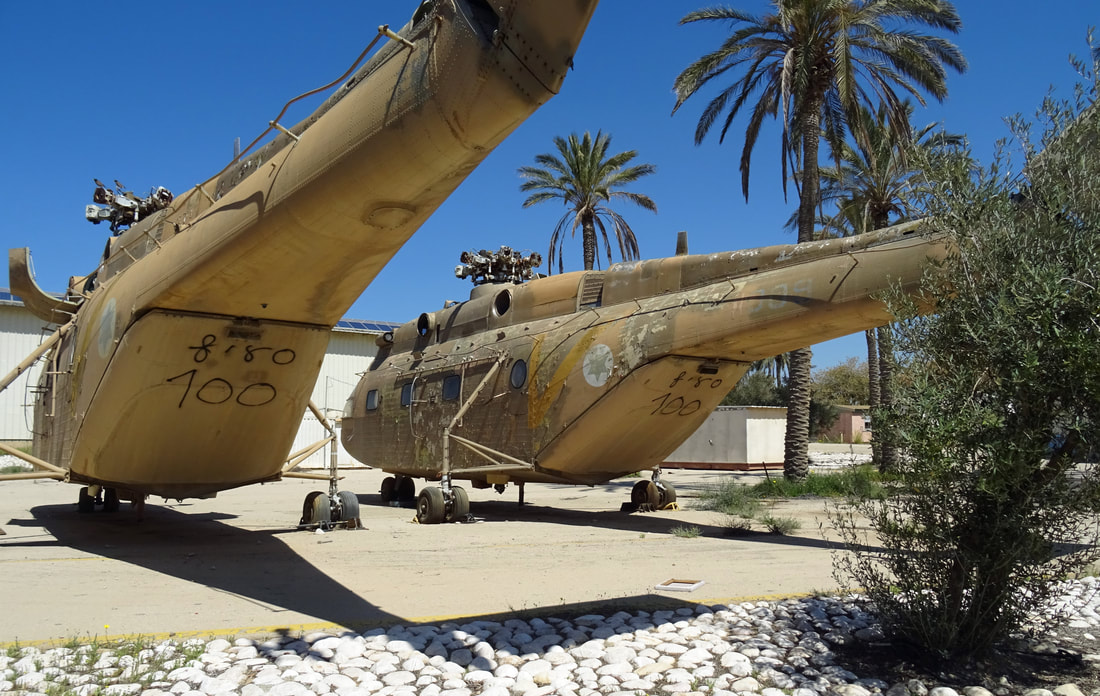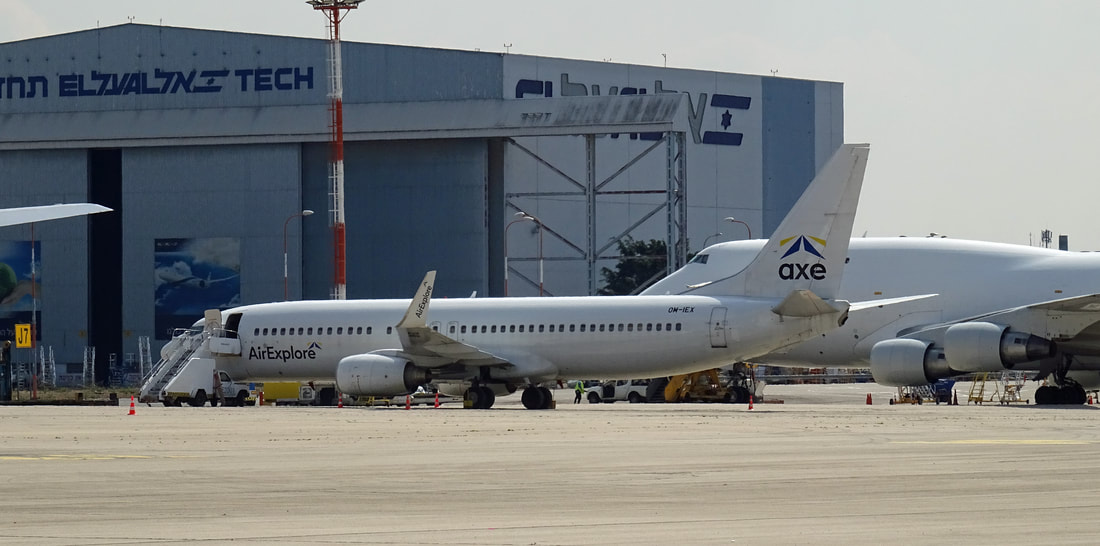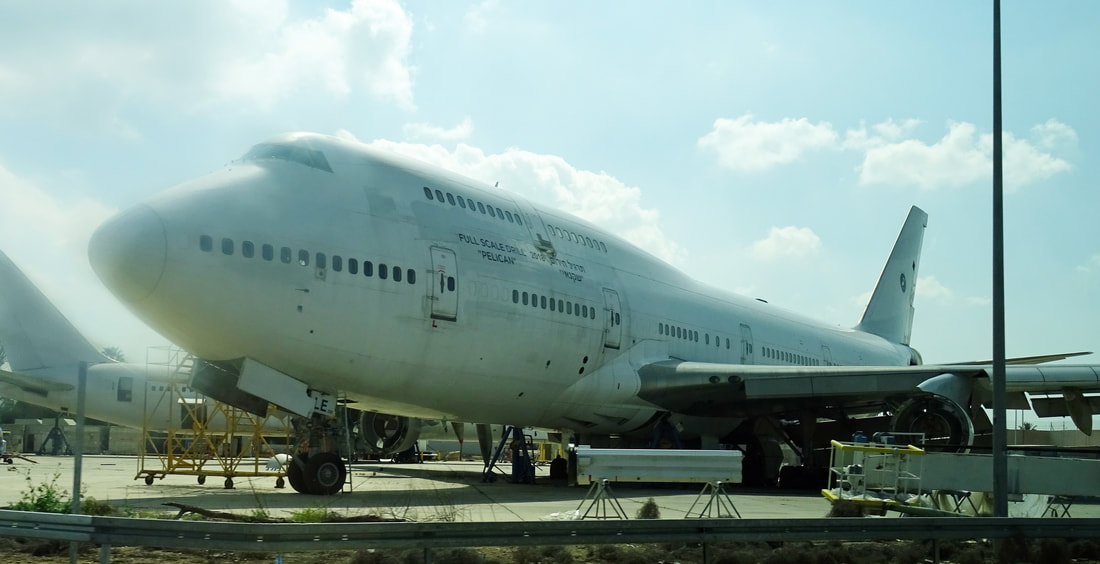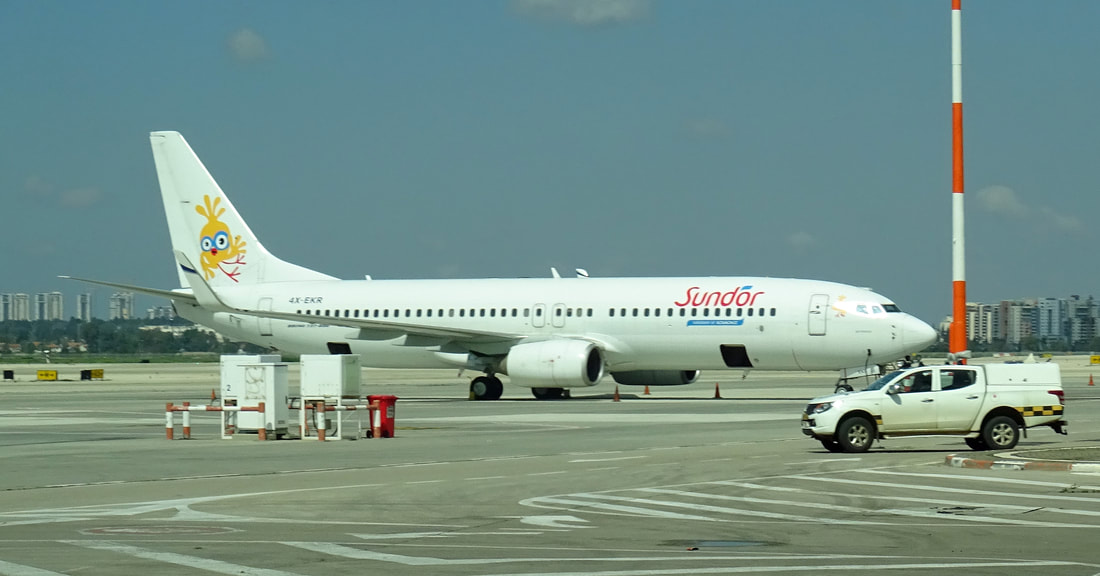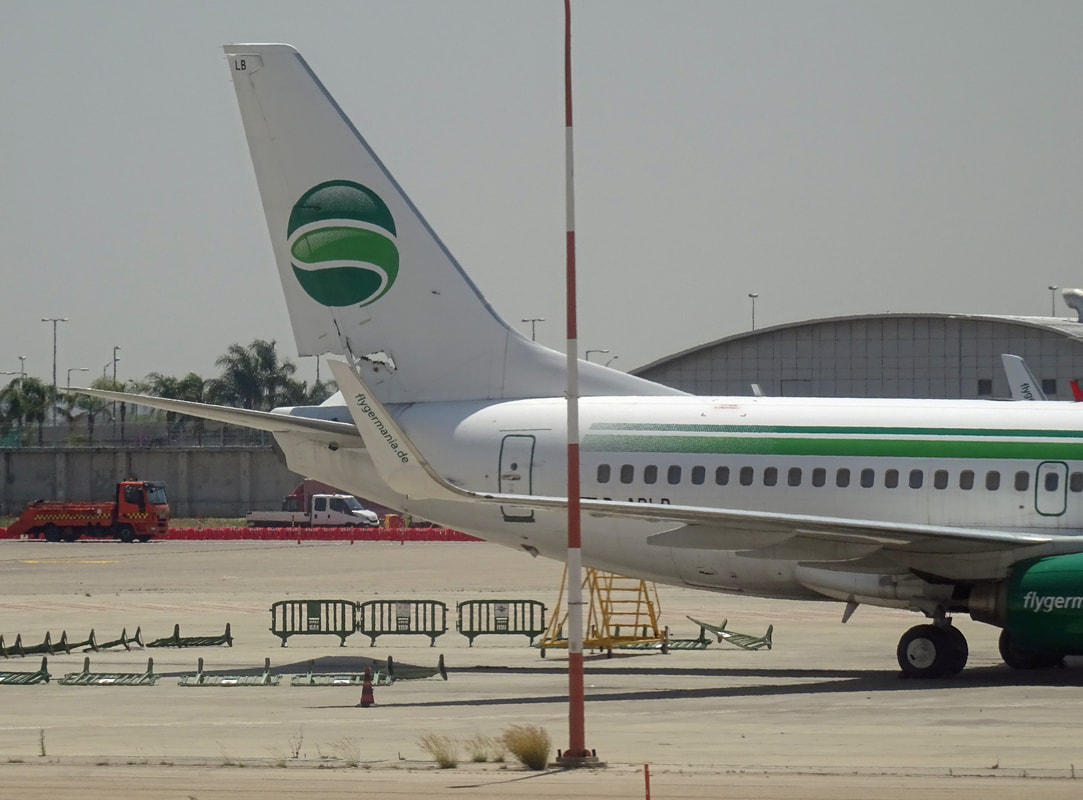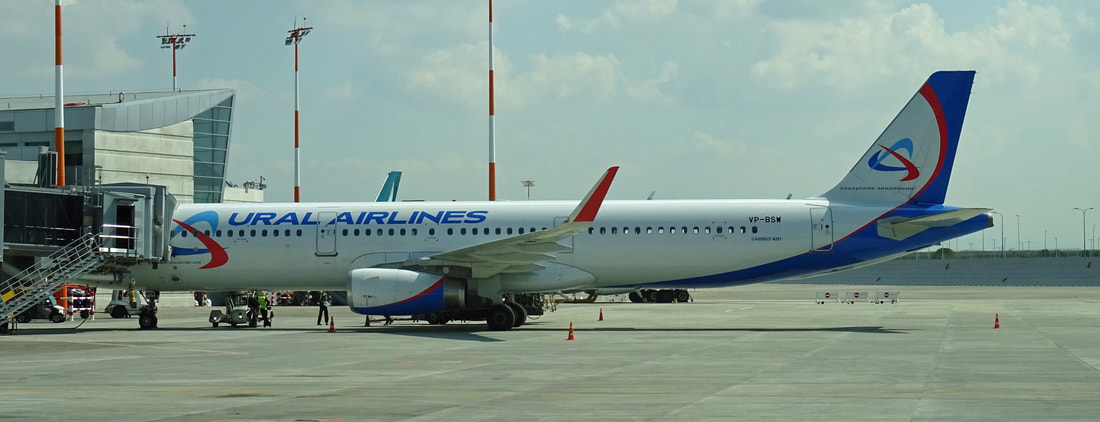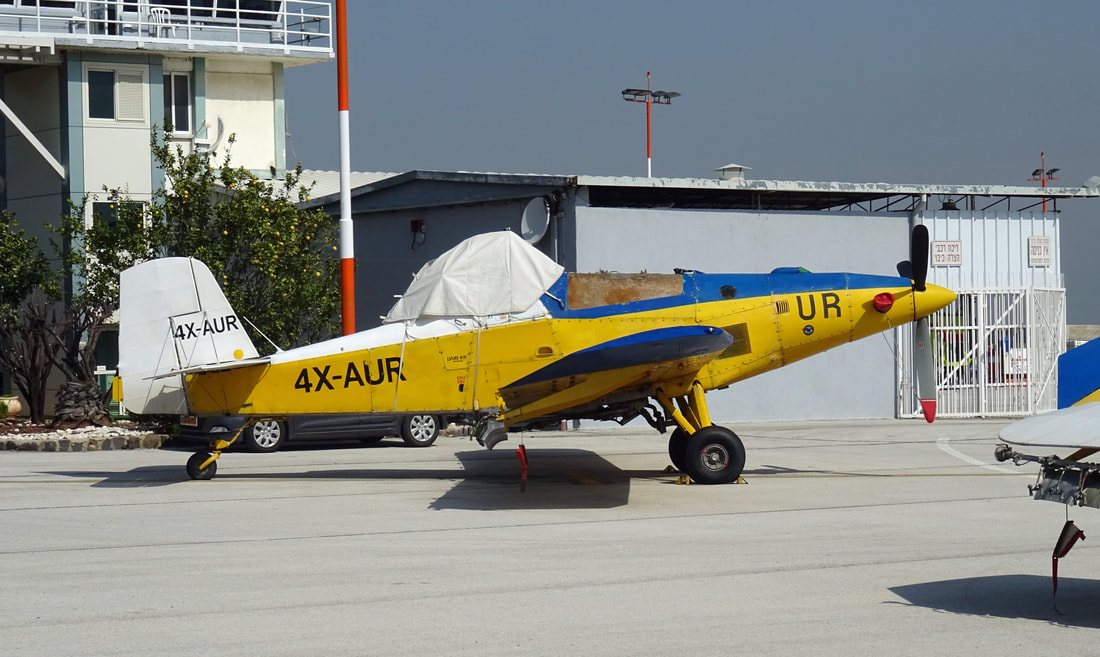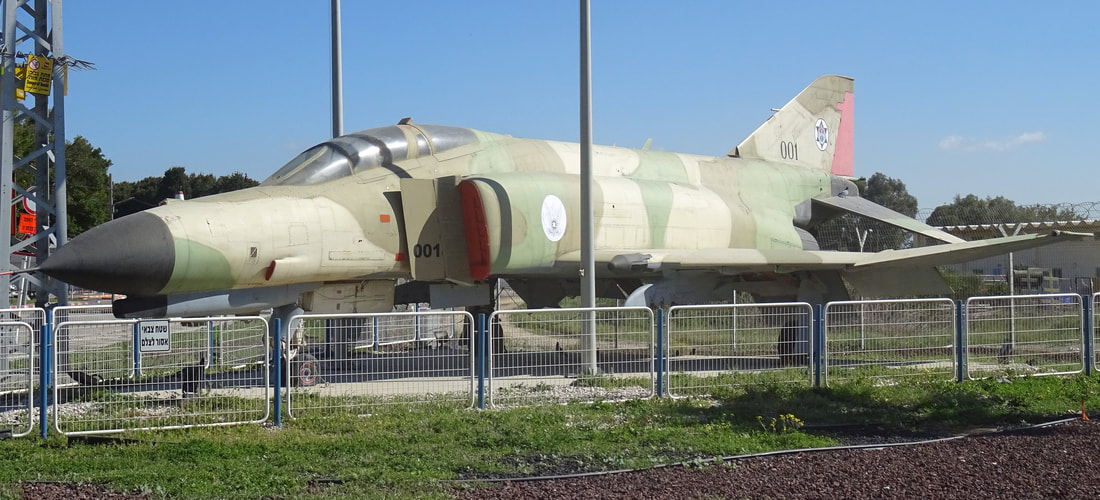Hatzerim Air Force museum
Beersheba, Israel
Part 02.
by Jan Koppen
North-Western Ramp
The Aérospatiale Alouette; company designations SA 313 and SA 318, is a French light helicopter originally manufactured by Sud Aviation and later Aérospatiale. It was the first production helicopter powered by a gas turbine engine instead of the heavier conventional piston powerplant.
On 12 March 1955, the prototype SE 3130 performed its maiden flight. The Alouette II was a widely used type and popular with operators, with over 1,300 rotorcraft eventually being constructed between 1956 and 1975. The type was predominantly used for military purposes in observation, photography, air-sea rescue, liaison and training, but it has also carried anti-tank missiles and homing torpedoes. As a civilian helicopter, the Alouette II has been used for casualty evacuation (with two external stretcher panniers), crop-spraying and as a flying crane, with a 500-kilogram (1,100 lb) external underslung load.
On 12 March 1955, the prototype SE 3130 performed its maiden flight. The Alouette II was a widely used type and popular with operators, with over 1,300 rotorcraft eventually being constructed between 1956 and 1975. The type was predominantly used for military purposes in observation, photography, air-sea rescue, liaison and training, but it has also carried anti-tank missiles and homing torpedoes. As a civilian helicopter, the Alouette II has been used for casualty evacuation (with two external stretcher panniers), crop-spraying and as a flying crane, with a 500-kilogram (1,100 lb) external underslung load.
These are the only remains of IAF’s P-51D Mustang ‘01’. She was built in 1948 and her serial was 2301 (c/n. D-141).
This wing with registration 4X-ADM belonged to a Fokker S-11 (c/n. 6232) which also served in the United States Army Air Corps (USAAC) 31-39.
The first versions were powered by four Pratt & Whitney JT-3C turbojet engines, producing 11,200 pounds of thrust (49,820 kilonewtons), and 13,500 pounds (60.051 kilonewtons) with water injection. This engine was a civil variant of the military J57 series.
Straight pipes
The early JT-3C’s had tow or three radial layers of pipes and some JT4 engines had a flower-style inner exhaust encompassed by pipes. There were noise compressors with 8-pipe and 10-pipe exhausts. Thus, one could not figure out which engine was installed by checking its noise compressor configuration. Qantas, for example, had Boeing 707-120’s fitted with JT-3C, that even had 21 tubes!
In the picture; - The retired Douglas c-47B 4X-FMJ / 042 of the Israeli Air Force sitting in a desolated corner of the IAF museum at Hatzerim Air Force base, Israel. March 2019.
4X-FMJ left the factory in 1944 for delivery to the USAAF. Originally this DC-3 has been manufactured in 1944 as a C-47B-30-DK. After the war she served the Royal Air Force and the French Air Force until she was sold to the Israeli oil company, Netivei Neft Oil as 4X-DCB. The aircraft changed hands once more when she was acquired by Israeli Air Force.
Douglas C-47 4X-FMJ/042 (33031/16283). Reported for sale in 2001 but found preservation at Hatzerim.
This C-47B is standing outside for years without any attention. Dirt has gathered in all the panel lines showing most clearly around the nose and engine cowlings.
Douglas C-47B 4X-FMJ 'spy-plane'. The aircraft is still festooned with a variety of aerials for direction finding, communications and other spooky hardware.
|
4X-FMJ left the factory in 1944 for delivery to the USAAF. Originally this DC-3 has been manufactured in 1944 as a C-47B-30-DK. After the war she served the Royal Air Force and the French Air Force until she was sold to the Israeli oil company, Netivei Neft Oil as 4X-DCB. The aircraft changed hands once more when she was acquired by Israeli Air Force.
On the left side; - Netivei Neft Oil 4X-DCB awaiting her passangers. |
4X-JYG/010 was formerly used by Israel Aircraft Industries as the testbed for the cancelled IAI Lavi fighter's nose radar.
Boeing 720-023 N7527A spent 14 years of its life operating for American in which she crisscrossed the North-Americas numerous times. In 1980 her service life with TWA was over and she was sold to Invicta in the UK as G-BCBB. During the '70s she changed hands numerous times and this short Boeing was owned by the following companies; - Somali Airlines, Tempair, DETA Linhas Aereas Mozambique, Cyprus airways, Air Ceylon and Monarch Airlines. In 1981 she was exported to Israel and charter airline Maof Airlines became the new owner. After for years with Maof she was sold to Israel Aircraft Industries as 4X-JYG(010) and used as a testbed for the Lavi fighter project. From 2008 she is parked at this remote area of the Hatzerim museum.
It looks like this 720 is covered by some form of moss.
This Boeing 720 was modified to be used as a radar testbed for IAI's Lavi fighter and now rests in this sad state at the Hatzerim Museum.
The Pratt & Whitney JT3D is an early turbofan aircraft engine derived from the Pratt & Whitney JT3C turbojet. It was first run in 1958 and was first flown in 1959 under a B-45 Tornado test aircraft. Over 8,000 JT3Ds were produced between 1959 and 1985. Most JT3D engines still in service today are used on military aircraft, where the engine is referred to by its USAF designation of TF33.
Aware of the competition from the Rolls-Royce Conway turbofan, Pratt & Whitney decided to develop the JT3D turbofan from the JT3C turbojet for later deliveries of the Boeing 707 and the Douglas DC-8, then nearing entry into service. A 2-stage fan replaced the first 3 stages of the 9-stage JT3C LP compressor. On the LP turbine, the second stage was enlarged and a third stage added.
Unlike GE with the CJ805-23, Pratt & Whitney had not undertaken any transonic fan research prior to designing the JT3D, so they were unable to incorporate a single stage unit into the specification. Instead P&W designed a 2-stage unit based on some research they had done to support the J91 nuclear turbojet.
On the Boeing 707 the JT3D fan nacelle was relatively short, whereas the Douglas DC-8 installation had a full length fan cowl. Pratt & Whitney provided a kit whereby JT3Cs could be converted to the JT3D standard in an overhaul shop.
In 1959, important orders for the engine were the Boeing 707-120B and Boeing 720B when American Airlines ordered one 707 powered by JT3D turbofans and KLM ordered a JT3D powered Douglas DC-8. The earlier 707s had been powered by the turbojet JT3C and the improved efficiency of the turbofan soon attracted the airlines. A JT3D powered 707-123B and 720-023B (the suffix B was to indicate a turbofan powered aircraft) entered service with American Airlines on the same day, March 12, 1961.
The Boeing KC-135 Stratotankers were all originally powered by turbojet engines. With the demise of many airline 707s the United States Air Force took the opportunity to buy the surplus airframes and use the engines to re-fit the KC-135As used by the Air National Guard and reserve squadrons with the civilian JT3D (designated TF33-PW-102). Over 150 aircraft were modified and the former KC-135A were re-designated the KC-135E.
After long service for both airlines and air forces, the number of JT3D powered aircraft is steadily decreasing. One hundred thirty five KC-135s use the JT3D while 354 were fitted with CFM International CFM56 engines, which provide greater thrust and increased operational flexibility due to their lower noise footprint. The noise of the JT3D is one of the reasons NATO has debated re-fitting their E-3 Sentry AWACS fleet, since the aircraft are subject to restrictions that aircraft with modern engines are not. Operational flexibility would be further increased due to the ability of higher power engines to increase the ceiling of the aircraft, extending the horizon for radar surveillance; for instance, RAF, French and Saudi E-3s routinely fly higher than NATO/USAF counterparts.
In 1961, the TF33 powered Boeing B-52H Stratofortress entered service. The "H" model of the B-52 was the only production variant of the heavy bomber to be fitted with turbofan engines, and is the only model remaining in United States Air Force service. It is expected to remain as a mainstay of the Air Force heavy bomber fleet until at least 2040, although options for replacing the 8 TF33 engines with more modern equivalents are being considered.
Aware of the competition from the Rolls-Royce Conway turbofan, Pratt & Whitney decided to develop the JT3D turbofan from the JT3C turbojet for later deliveries of the Boeing 707 and the Douglas DC-8, then nearing entry into service. A 2-stage fan replaced the first 3 stages of the 9-stage JT3C LP compressor. On the LP turbine, the second stage was enlarged and a third stage added.
Unlike GE with the CJ805-23, Pratt & Whitney had not undertaken any transonic fan research prior to designing the JT3D, so they were unable to incorporate a single stage unit into the specification. Instead P&W designed a 2-stage unit based on some research they had done to support the J91 nuclear turbojet.
On the Boeing 707 the JT3D fan nacelle was relatively short, whereas the Douglas DC-8 installation had a full length fan cowl. Pratt & Whitney provided a kit whereby JT3Cs could be converted to the JT3D standard in an overhaul shop.
In 1959, important orders for the engine were the Boeing 707-120B and Boeing 720B when American Airlines ordered one 707 powered by JT3D turbofans and KLM ordered a JT3D powered Douglas DC-8. The earlier 707s had been powered by the turbojet JT3C and the improved efficiency of the turbofan soon attracted the airlines. A JT3D powered 707-123B and 720-023B (the suffix B was to indicate a turbofan powered aircraft) entered service with American Airlines on the same day, March 12, 1961.
The Boeing KC-135 Stratotankers were all originally powered by turbojet engines. With the demise of many airline 707s the United States Air Force took the opportunity to buy the surplus airframes and use the engines to re-fit the KC-135As used by the Air National Guard and reserve squadrons with the civilian JT3D (designated TF33-PW-102). Over 150 aircraft were modified and the former KC-135A were re-designated the KC-135E.
After long service for both airlines and air forces, the number of JT3D powered aircraft is steadily decreasing. One hundred thirty five KC-135s use the JT3D while 354 were fitted with CFM International CFM56 engines, which provide greater thrust and increased operational flexibility due to their lower noise footprint. The noise of the JT3D is one of the reasons NATO has debated re-fitting their E-3 Sentry AWACS fleet, since the aircraft are subject to restrictions that aircraft with modern engines are not. Operational flexibility would be further increased due to the ability of higher power engines to increase the ceiling of the aircraft, extending the horizon for radar surveillance; for instance, RAF, French and Saudi E-3s routinely fly higher than NATO/USAF counterparts.
In 1961, the TF33 powered Boeing B-52H Stratofortress entered service. The "H" model of the B-52 was the only production variant of the heavy bomber to be fitted with turbofan engines, and is the only model remaining in United States Air Force service. It is expected to remain as a mainstay of the Air Force heavy bomber fleet until at least 2040, although options for replacing the 8 TF33 engines with more modern equivalents are being considered.
This Boeing 720 shows signs of fretting along the Kenya Airways cowl panels. The dark fuzzy stains extend back from the lower cowl panel fasteners. It doesn't matter how careful the ground crews are, fuel and oil etc., gets spilled on and wiped off airplanes. It is likely that around any of the liquid fill up points, that there will be staining of the paint work, in addition to chipped and worn paint work around the filler caps.
If the airplane is stored outside, it will be subject to wind, rain, hail and whatever else the local climate can throw at it. Why do your house windows need cleaning? Because rain deposits sand and dust on them. An airplane stored outside will be subject to streaking down the paintwork from dust and dirt deposits unless washed regularly.
The Boeing 707-320 was a Top Jetliner.
4X-JYW/103 is a Boeng 707-328 (msn. 173617) and a former Air France (F-BHSE) flagship which was sold to the Israeli Air Force. She is "on display" at the Israeli Air Force Museum of Hatzerim, close near the desert city of Beersheba.
Until 1978 Air France employed this Boeing 707-328, as F-BHSE, on their prestigious passenger service to locations in their far-flung network. In 1978 she was exported to Israel for employment with Israeli Air Force as 4X-JYW. Since 1996 she is parked at this remote area of the Hatzerim museum.
Paint is oxidizing and there may be numerous areas of chipping on lower surfaces of aircraft.
Also the leading edges show significant signs of abrasion wear.
Also the leading edges show significant signs of abrasion wear.
Cocooning is the practice of coating aircraft for protection. It seems 103 received, many years ago, some form of a liquid coating to form a protective layer, that should protect her surfaces, during long-term storage, from dirt, damage, weathering and extreme sunlight.
The first versions were powered by four Pratt & Whitney JT-3C turbojet engines, producing 11,200 pounds of thrust (49,820 kilonewtons), and 13,500 pounds (60.051 kilonewtons) with water injection. This engine was a civil variant of the military J57 series. It was a two-spool axial-flow turbojet engine with a 16-stage compressor and 2 stage turbine. The JT3C-6 was 11 feet, 6.6 inches (3.520 meters) long, 3 feet, 2.9 inches (0.988 meters) in diameter, and weighed 4,235 pounds (1,921 kilograms).
In the early 60’s, many Boeing 707’s were upgraded to the 707-120B standard. This included a change from the turbojet engines to quieter, more powerful and efficient Pratt & Whitney JT3D-1. The JT3D-1 was a dual-spool axial-flow turbofan engine, with a 2-stage fan section, 13-stage compressor, 8 combustion chambers and a 4-stage turbine (1 high- and 3 low-pressure stages). This engine was rated at 14,500 pounds of static thrust (64.499 kilonewtons) at Sea Level, and 17,000 pounds (75.620 kilonewtons), with water injection, for takeoff (2½ minute limit). Almost half of the engine’s thrust was produced by the fans. The JT3C could be converted to the JT3D configuration during overhaul.
In the early 60’s, many Boeing 707’s were upgraded to the 707-120B standard. This included a change from the turbojet engines to quieter, more powerful and efficient Pratt & Whitney JT3D-1. The JT3D-1 was a dual-spool axial-flow turbofan engine, with a 2-stage fan section, 13-stage compressor, 8 combustion chambers and a 4-stage turbine (1 high- and 3 low-pressure stages). This engine was rated at 14,500 pounds of static thrust (64.499 kilonewtons) at Sea Level, and 17,000 pounds (75.620 kilonewtons), with water injection, for takeoff (2½ minute limit). Almost half of the engine’s thrust was produced by the fans. The JT3C could be converted to the JT3D configuration during overhaul.
The early JT-3C’s had two or three radial layers of pipes and some JT4 engines had a flower-style inner exhaust encompassed by pipes. There were noise compressors with 8-pipe and 10-pipe exhausts. Thus, one could not figure out which engine was installed by checking its noise compressor configuration. Qantas, for example, had Boeing 707-120’s fitted with JT-3C, that even had 21 tubes!
Ramps on the western side
The Nord Noratlas was a dedicated military transport aircraft, developed and manufactured by French aircraft manufacturer Nord Aviation.
Development commenced during the late 1940s with the aim of producing a suitable aircraft to replace the numerous older types that were in service with the Armée de l'Air (French Air Force) which dated back to the Second World War. In response to a competition organised by the Direction Technique Industrielle (DTI), Nord produced their Nord 2500 proposal, which was selected as the most promising. Experiences with the first prototype, powered by Gnome-Rhône 14R engines, did not impress, thus the design was revised as the Nord 2501, powered by the SNECMA-built Bristol Hercules 738/9 engines instead, which was found acceptable. Accordingly, the Noratlas was introduced to service by the Armée de l'Air on 6 December 1953.
4X-FAC/043 (c/n. D-134) is a Nord 2501D Noratlas. She is ex German Air Force.
Development commenced during the late 1940s with the aim of producing a suitable aircraft to replace the numerous older types that were in service with the Armée de l'Air (French Air Force) which dated back to the Second World War. In response to a competition organised by the Direction Technique Industrielle (DTI), Nord produced their Nord 2500 proposal, which was selected as the most promising. Experiences with the first prototype, powered by Gnome-Rhône 14R engines, did not impress, thus the design was revised as the Nord 2501, powered by the SNECMA-built Bristol Hercules 738/9 engines instead, which was found acceptable. Accordingly, the Noratlas was introduced to service by the Armée de l'Air on 6 December 1953.
Following its adoption by the Armée de l'Air, a number of other operators in both Europe and Africa chose to procure the Noratlas for their own military air services. Having found itself in a similar situation to France, the German Air Force of West Germany chose to adopt the same solution, procuring the type for their own purposes.
The sizable cabin of the Noratlas was capable of accommodating up to 7.5 short tons of freight or a maximum of 40 passengers; when flown at a cruising speed of 200 mph, it could transport a 6-ton payload over a range of up to 750 miles.[4] Cargo was typically loaded into and unloaded from the main cabin via the rear-facing clamshell doors, which were intentionally positioned close to ground level to ease freight handling.[1]
The Nord 2501D, with its rear-opening clamshell doors and tricycle undercarriage, allowed ease of loading.
Paint chipping, dents and scratches all happen during maintenance. Panels and cowls are frequently removed resulting in replacement screws and distorted panel edges. The replacement screws are unlikely to be painted. Paint will wear away on areas frequently walked on or held, such as the wing roots and hand holds etc.
4X-FAG/055 (c/n. D-165) is a Nord 2501D Noratlas. She is ex German Air Force.
The Nord 2501D (perhaps the 'D' stand for Deutsland?)was the production version for the German Air Force, replaced some systems components of the N2501 with their equivalent from German manufacturers, 186 built (25 French built and 161 German built).
Oil leaks are also found around the bottom of the engine cowl and, ofcourse, on the tarmac under the engines.
Following its adoption by the Armée de l'Air, a number of other operators in both Europe and Africa chose to procure the Noratlas for their own military air services. Having found itself in a similar situation to France, the German Air Force of West Germany chose to adopt the same solution, procuring the type for their own purposes.
The Israeli Air Force, the Hellenic Air Force, and the Portuguese Air Force all deployed the Noratlas under combat conditions. Furthermore, operators often found a wide variety of uses for the type, extensively adapting aircraft to suit secondary roles in some cases. The Noratlas was also adopted by a number of civil operators, although most aircraft were flown by military customers. As such, several hundred aircraft were produced during the Noratlas' production run, which lasted over a decade.
It was decided to power the second prototype with English Bristol Hercules type 739 engines, developing 2,040 hp on takeoff, to which Rotol four blade props were fitted. From then on it was designated Nord 2501.
The first order was placed on July 10th 1951, and the first production aircraft flew on November 24th 1952, in the hands of Georges Détré. Not until early 1953 was the plane dubbed Noratlas.
While the SNCAN factory at Les Mureaux manufactured the booms and tails, the factory at Bourges made the fuselage. Breguet manufactured the wings and, under licensing, the Rotol propellers. SNECMA also had a licence for the Hercules 738 and 739 engines. Initially the final assembly took place at either Les Mureaux or Bourges, at the end only Bourges did it. 426 aircraft of all versions were eventually produced, including 8 prototypes and 3 pre-production aircraft.
The first order was placed on July 10th 1951, and the first production aircraft flew on November 24th 1952, in the hands of Georges Détré. Not until early 1953 was the plane dubbed Noratlas.
While the SNCAN factory at Les Mureaux manufactured the booms and tails, the factory at Bourges made the fuselage. Breguet manufactured the wings and, under licensing, the Rotol propellers. SNECMA also had a licence for the Hercules 738 and 739 engines. Initially the final assembly took place at either Les Mureaux or Bourges, at the end only Bourges did it. 426 aircraft of all versions were eventually produced, including 8 prototypes and 3 pre-production aircraft.
Damage to the fuselage sied of multi-engine airplanes is likely due to ice breaking from propellor blades when de-icing equipment is in use.
During 1959, having been suitably impressed by its use under combat conditions, the IAF purchased another three N-2501ISs; prior to the Six-Day War of 1967, an additional 16 ex-German Air Force N-2501Ds had also been acquired and put into service. The Noratlas fleet was primarily intended for cargo and paratroop transport, although several aircraft conducted more unconventional operations, being used as improvised bomber aircraft to perform long-range strike missions into Egypt (known as Operation Drought), much as the contemporary C-130s deployed the Daisy Cutter bomb in Vietnam. Amongst the other secondary roles that the IAF are known to have used their Noratlases for included maritime reconnaissance at the outset of the Six-Day War. It has been claimed that an IAF Noratlas had supposedly identified the USS Liberty prior to the USS Liberty Incident. During 1978, the IAF retired the last of their Noratlas fleet.
The Nord Noratlas was a purpose-built twin-engine, twin-boom transport aircraft. It featured a large pod-like fuselage that was slung in between the aircraft's twin booms and indirectly attached to them via its shoulder-mounted wing. The Noratlas was deliberately designed to be operated under austere conditions, featuring widely spaced landing gear, complete with wide low-pressure tyres, for additional stability and suitability to moving over rough terrain, while the propellers had sufficient clearance to accommodate such operations as well.
An airplane stored outside will be subject to streaking down the paintwork from dust and dirt deposits unless washed regularly.
Southern side storage dump
‘173’ is a Dassault MD.452 Mystere IV A.
If an airplane is stored outside, it will be subject to wind, rain, hail and whatever else the local climate can throw at it. She will be subject to streaking down the paintwork from dust and dirt deposits unless washed regularly.
Those Mystère's wear out in the weather.
The Mystère IVA was a fighter-bomber, 421 built, first 50 with the Rolls-Royce Tay 250 the remaining 371 with a French derivative of the Tay, the Hispano-Suiza Verdon.
'007' Dassault MD.450 Ouragan is seen here surrounded by aeronautical trash.
‘11’ is a Dassault MD.454 Mystere IV A.
The Mystère IV became Israel's first swept-wing fighter when an order for Mystère IIs was changed to 24 Mystère IVs in 1955, which were delivered from April to June 1956, equipping 101 Squadron. A further 36 were delivered in August 1956, with a final aircraft, equipped for reconnaissance duties, delivered in September 1956.
On 29 October 1956, when Israel attacked Egypt in the opening move of what became known as the Suez Crisis, invading the Sinai Peninsula, the Mystères of 101 Squadron were deployed on both air-to-air and ground attack missions. On 30 October the Mystère IV got its first kill when eight aircraft fought 16 Egyptian Air Force MiG-15s. The Mystères shot down one MiG while a second MiG and one of the Mystères were damaged. On the next day, two Mystères engaged claimed four Egyptian De Havilland Vampires shot down, with another MiG-15 and a MiG-17 claimed later that day. Israeli Mystères flew a total of 147 sorties during the war, for the loss of a single aircraft, shot down by ground fire on 2 November.
A second squadron, 109 Squadron was equipped with the Mystère IV in December 1956, while 101 Squadron passed its Mystères to 116 Squadron in November 1961. Israel planned to replace the Mystère IV with the Douglas A-4 Skyhawk, but 109 and 116 Squadron still operated the French fighter on the outbreak of the Six-Day War. The Mystère was used as a ground attack aircraft during the war, flying 610 sorties, claiming three Arab aircraft (two MiG-17s and a Jordanian Hawker Hunter) shot down for the loss of seven Mystères, five to ground fire and two by enemy fighters (one by an Egyptian MiG-21 and one by a Jordanian Hunter flown by PAF pilot Saiful azam).
The Mystère was finally retired from Israeli service on 18 March 1971.
On 29 October 1956, when Israel attacked Egypt in the opening move of what became known as the Suez Crisis, invading the Sinai Peninsula, the Mystères of 101 Squadron were deployed on both air-to-air and ground attack missions. On 30 October the Mystère IV got its first kill when eight aircraft fought 16 Egyptian Air Force MiG-15s. The Mystères shot down one MiG while a second MiG and one of the Mystères were damaged. On the next day, two Mystères engaged claimed four Egyptian De Havilland Vampires shot down, with another MiG-15 and a MiG-17 claimed later that day. Israeli Mystères flew a total of 147 sorties during the war, for the loss of a single aircraft, shot down by ground fire on 2 November.
A second squadron, 109 Squadron was equipped with the Mystère IV in December 1956, while 101 Squadron passed its Mystères to 116 Squadron in November 1961. Israel planned to replace the Mystère IV with the Douglas A-4 Skyhawk, but 109 and 116 Squadron still operated the French fighter on the outbreak of the Six-Day War. The Mystère was used as a ground attack aircraft during the war, flying 610 sorties, claiming three Arab aircraft (two MiG-17s and a Jordanian Hawker Hunter) shot down for the loss of seven Mystères, five to ground fire and two by enemy fighters (one by an Egyptian MiG-21 and one by a Jordanian Hunter flown by PAF pilot Saiful azam).
The Mystère was finally retired from Israeli service on 18 March 1971.
'4010' is a former Czech Air Force Mil Mi-24D Hind.
'106' is a Piper Navajo.
Southern side hangars and ramp
Enjoying the early spring sun is this IAF’s Supermarine Spitfire Mk. IX, serial ‘78’.
The Supermarine Spitfire is a British single-seat fighter aircraft used by the Royal Air Force and other Allied countries before, during, and after World War II. Many variants of the Spitfire were built, using several wing configurations, and it was produced in greater numbers than any other British aircraft. It was also the only British fighter produced continuously throughout the war.
The Spitfire was designed as a short-range, high-performance interceptor aircraft by R. J. Mitchell, chief designer at Supermarine Aviation Works, which operated as a subsidiary of Vickers-Armstrong from 1928. Mitchell pushed the Spitfire's distinctive elliptical wing with cutting-edge sunken rivets (designed by Beverley Shenstone) to have the thinnest possible cross-section, helping give the aircraft a higher top speed than several contemporary fighters, including the Hawker Hurricane. Mitchell continued to refine the design until his death in 1937, whereupon his colleague Joseph Smith took over as chief designer, overseeing the Spitfire's development through its multitude of variants.
The Spitfire was designed as a short-range, high-performance interceptor aircraft by R. J. Mitchell, chief designer at Supermarine Aviation Works, which operated as a subsidiary of Vickers-Armstrong from 1928. Mitchell pushed the Spitfire's distinctive elliptical wing with cutting-edge sunken rivets (designed by Beverley Shenstone) to have the thinnest possible cross-section, helping give the aircraft a higher top speed than several contemporary fighters, including the Hawker Hurricane. Mitchell continued to refine the design until his death in 1937, whereupon his colleague Joseph Smith took over as chief designer, overseeing the Spitfire's development through its multitude of variants.
Israel's first Spitfires were built from RAF Spitfire wrecks, parts recovered from downed Egyptian aircraft and RAF scrap. Israel bought 59 Spitfire LF IXc from Czechoslovakia in 1948 to address its lack of fighters. They joined 101 Squadron and enhanced the IAF's combat capability, although only 17 arrived in time to fight. During the October offensive, Spitfires escorted Beaufighters and B-17s to attack El Arish airbase and other targets. They also intercepted Egyptian Spitfires and Machis, shooting down several.
In 1952 an additional 35 LF IXc/e aircraft were purchased from Italy, at which time the Spitfire in IDF service was known as the "Yorek". After a few years of operational use and major action during the 1948 Arab–Israeli War these Spitfires were sold to Burma.
In 1952 an additional 35 LF IXc/e aircraft were purchased from Italy, at which time the Spitfire in IDF service was known as the "Yorek". After a few years of operational use and major action during the 1948 Arab–Israeli War these Spitfires were sold to Burma.
The Spitfire Mk IX was very much a stop-gap solution to an unforeseen new development in the capabilities of enemy fighters, namely the appearance of the Focke-Wulf Fw 190. When the latter arrived at the Channel front in September 1941, this new aircraft was markedly superior to the then-predominant British fighter, the Spitfire Mk. Vb. The next planned Spitfire general-purpose fighter, the Mk. VIII, incorporated several refinements developed in the previously developed Mk. III prototype, and extensive re-tooling was necessary to get production underway. The main improvement of the Mk. VIII, however, laid in the introduction of the new two-stage two-speed-supercharged Merlin engines, and the most expedient solution to make these available to the RAF was to adapt the readily available Mk. V airframe to this engine.
Thus, the first 100 or so examples of the Mk IX were simply conversions of Mk Vc airframes, performed either at Rolls-Royce or at Supermarine.
As is so often seen, temporary solutions become permanent; so great was the Mk. IX’s success that it ended up as the second-most produced Spitfire mark. Counting also the very similar Mk. XVI, the overall production of this type of the Spitfire actually surpasses that of the Mk. V.
One consequence of the rushed introduction of this version was that numerous refinements could be, and were made during its long production run. This made the Mk. IX also the most heterogeneous Spitfire version.
Thus, the first 100 or so examples of the Mk IX were simply conversions of Mk Vc airframes, performed either at Rolls-Royce or at Supermarine.
As is so often seen, temporary solutions become permanent; so great was the Mk. IX’s success that it ended up as the second-most produced Spitfire mark. Counting also the very similar Mk. XVI, the overall production of this type of the Spitfire actually surpasses that of the Mk. V.
One consequence of the rushed introduction of this version was that numerous refinements could be, and were made during its long production run. This made the Mk. IX also the most heterogeneous Spitfire version.
Israeli AF 002, DH89A Dragon Rapide, ex RL981/G-AKRS at the Israeli AF Museum Hatzerim, March 2019.
|
The de Havilland DH.89 Dragon Rapide was a 1930s short-haul biplane airliner developed and produced by British aircraft company de Havilland. Capable of accommodating 6–8 passengers, it proved an economical and durable craft, despite its relatively primitive plywood construction.
Developed during the early 1930s, the Dragon Rapide was essentially a smaller, twin-engined version of the four-engined DH.86 Express, and shared a number of common features, such as its tapered wings, streamlined fairings and Gipsy Six engines. First named the "Dragon Six", the type was marketed as "Dragon Rapide" and later simply known as the "Rapide". Upon its introduction in summer 1934, it proved to be a popular aircraft with airlines and private civil operators alike, attaining considerable foreign sales in addition to its domestic use. |
'068' is a Piper 18-150 Super Cub.
Crying out for cosmetic attention.
'05' is a Fokker S-11.
Despited being hangared this North-American Harvard '25' is looking a bit grubby.
The first Fouga arrived in Israel in 1957 and shortly later local license-manufacturing was started by IAI, with the aircraft named the IAI Tzukit. The first Tzukit was completed in 1959 and entered service in 1960.
IAI Westwind 1121 Jet Commander 4X-COA seen preserved at Israel Air Force museum, Hatzerim in March 2019.
The IAI Westwind is a business jet initially produced by Aero Commander as the 1121 Jet Commander. Powered by twin GE CJ610 turbojets, it first flew on January 27, 1963 and received its type certification on November 4, 1964, before the first delivery. The program was bought by Israel Aircraft Industries (IAI) in 1968, which stretched it slightly into the 1123 Westwind, and then re-engined it with Garrett TFE731 turbofans into the1124 Westwind. The 16,800–23,500 lb (7.6–10.7 t) MTOW aircraft can carry up to 8 or 10 passengers, and 442 were produced until 1987.
The weird nose is adapted from the MiG-21 'Fishbed'. Note the "Experimental" sticker.
|
Jet Commander production amounted to 150 aircraft in the United States and Israel before IAI undertook a series of modifications to create the 1123 Westwind. These included stretching the fuselage and increased maximum takeoff, maximum landing, and maximum zero-fuel weights, with the wing modified to incorporate double-slotted flaps and drooped leading edges and tip tanks. The trimmable horizontal stabilizer was also modified to have increased span and more travel. Not long after the aircraft went into production, the original General Electric CJ610 turbojet engines were replaced by more fuel-efficient Garrett TFE731 turbofans. There were also numerous airframe modifications, such as drooped leading edges on the wings, a dorsal fin, revised engine pylons and nacelles, and further increases in maximum takeoff, maximum landing, and maximum zero-fuel weights. With improvements to a number of onboard systems incorporated as well, these changes resulted in the 1124 Westwind delivered from 1976.
In 1976, in the wake of the terrorist takeover of the Savoy hotel in Tel Aviv, the Israeli Air Force decided to use the Westwind as the basis for a maritime patrol aircraft, which became known as the IAI Sea Scan. It had originally been developed to meet a requirement for the United States Coast Guard to replace the Grumman HU-16 Albatross. The Dassault Falcon was selected instead. |
The Israeli Air Force was the largest foreign operator of the Phantom, flying both newly built and ex-USAF aircraft, as well as several one-off special reconnaissance variants. The first F-4Es, nicknamed "Kurnass" (Sledgehammer), and RF-4Es, nicknamed "Orev" (Raven), were delivered in 1969 under the "Peace Echo I" program. Additional Phantoms arrived during the 1970s under "Peace Echo II" through "Peace Echo V" and "Nickel Grass" programs. Israeli Phantoms saw extensive combat during Arab–Israeli conflicts, first seeing action during the War of Attrition. In the 1980s, Israel began the "Kurnass 2000" modernization program which significantly updated avionics. The last Israeli F-4s were retired in 2004.
This 'blue hardware' is a Grumman (General Motors) TBM-3E Avenger.
Her paint is of poor quality, oxidized and shows excessive wear on leading edges and control surfaces. Many chips and scratches are apparent and overall the aircraft needs painting.
'944' is a Grumman E-2C Hawkey.
The Northrop Grumman E-2 Hawkeye is an American all-weather, carrier-capable tactical airborne early warning (AEW) aircraft. This twin-turboprop aircraft was designed and developed during the late 1950s and early 1960s by the Grumman Aircraft Company for the United States Navy as a replacement for the earlier, piston-engined E-1 Tracer, which was rapidly becoming obsolete. The aircraft's performance has been upgraded with the E-2B, and E-2C versions, where most of the changes were made to the radar and radio communications due to advances in electronic integrated circuits and other electronics. The fourth major version of the Hawkeye is the E-2D, which first flew in 2007. The E-2 was the first aircraft designed specifically for its role, as opposed to a modification of an existing airframe, such as the Boeing E-3 Sentry. Variants of the Hawkeye have been in continuous production since 1960, giving it the longest production run of any carrier-based aircraft.
Three sisterships got to go to Mexico, but 944 stayed home and become an exhibit in the Israel Air Force Museum.
Israel was the first export customer; its four Hawkeyes were delivered during 1981, complete with the folding wings characteristic of carrier-borne aircraft. The four examples were soon put into active service before and during the 1982 Lebanon War during which they won a resounding victory over Syrian air defenses and fighter control. They were central to the Israeli victory in the air battles over the Bekaa Valley during which more than 90 Syrian fighters were downed. The Hawkeyes were also the linchpins of the operation in which the IAF destroyed the surface-to-air missile (SAM) array in the Bekaa, coordinating the various stages of the operation, vectoring planes into bombing runs and directing intercepts. Under constant escort by F-15 Eagles, there were always two Hawkeyes on station off the Lebanese coast, controlling the various assets in the air and detecting any Syrian aircraft upon their takeoff, eliminating any chance of surprise.
The Israeli Air Force (IAF) operated four E-2s for its homeland AEW protection through 1994. The IAF was the first user of the E-2 to install air-to-air refueling equipment.
Three of the four Israeli-owned Hawkeyes were sold to Mexico in 2002 after they had been upgraded with new systems; the remaining example was sent to be displayed in the Israeli Air Force Museum. In 2010, Singapore began retiring its E-2Cs as well. Both Israel and Singapore now employ the Israel Aerospace Industries (IAI) Eitam, a Gulfstream G550-based platform with Elta's EL/W-2085 sensor package (a newer derivative of the airborne Phalcon system) for their national AEW programs.
The Israeli Air Force (IAF) operated four E-2s for its homeland AEW protection through 1994. The IAF was the first user of the E-2 to install air-to-air refueling equipment.
Three of the four Israeli-owned Hawkeyes were sold to Mexico in 2002 after they had been upgraded with new systems; the remaining example was sent to be displayed in the Israeli Air Force Museum. In 2010, Singapore began retiring its E-2Cs as well. Both Israel and Singapore now employ the Israel Aerospace Industries (IAI) Eitam, a Gulfstream G550-based platform with Elta's EL/W-2085 sensor package (a newer derivative of the airborne Phalcon system) for their national AEW programs.
Three Super Frelons in a row at Hatzerim AFM. The numbers are from left to right; - '009', '321' and '021'.
The Aérospatiale (formerly Sud Aviation) SA 321 Super Frelon ("Super Hornet") is a three-engined heavy transport helicopter produced by aerospace manufacturer Sud Aviation (later Aérospatiale) of France. It held the distinction of being the most powerful helicopter to be built in Europe at one point, as well as being the world's fastest helicopter.
Her paint is oxidizing and there are numerous areas of chipping on upper surfaces of aircraft.
The Super Frelon was a more powerful development of the original SE.3200 Frelon, which had failed to enter production. On 7 December 1962, the first prototype conducted the type's maiden flight. On 23 July 1963, a modified Super Frelon flew a record-breaking flight, setting the new FAI absolute helicopter world speed record with a recorded speed of 217.7 mph (350.4 km/h). Both civilian and military versions of the Super Frelon were produced; the type was predominantly sold to military customers. In 1981, Aerospatiale, Sud Aviation's successor company, chose to terminate production due to a lack of orders.
During 1965, Israel placed an order for six SA 321K Super Frelons to equip the Israeli Air Force with a heavy lift transport capability. On 20 April 1966, the first of these rotorcraft arrived, enabling the inauguration of 114 Squadron, which operated the type out of Tel Nof. An additional six Super Frelons were ordered during the following year. The Israeli military had initially hoped to use the Super Frelons for deploying Panhard AML-90 light armoured cars in support of airborne operations, but this concept was dropped when tests revealed the helicopter was incapable of handling the vehicle's combat weight. A total of four helicopters had arrived by the start of the 1967 Six-Day War, during which they flew 41 sorties. Israeli Super Frelons saw extensive service during the War of Attrition, participating in operations such as Helem, Tarnegol 53 and Rhodes.
The type was once again in service during the Yom Kippur War, following which Israel replaced the original Turbomeca Turmo engines with the 1,390 kW (1,870 shp) General Electric T58-GE-T5D engine. The Super Frelons also took part in the Israeli invasion of Lebanon in June 1982.
Due to their relatively high maintenance cost and poor performance capabilities compared to the IAF CH-53s, they were finally retired in 1991.
The type was once again in service during the Yom Kippur War, following which Israel replaced the original Turbomeca Turmo engines with the 1,390 kW (1,870 shp) General Electric T58-GE-T5D engine. The Super Frelons also took part in the Israeli invasion of Lebanon in June 1982.
Due to their relatively high maintenance cost and poor performance capabilities compared to the IAF CH-53s, they were finally retired in 1991.
The Aérospatiale SA 321 Super Frelon is a large, heavy-lift single-rotor helicopter, furnished with a relatively atypical three-engine configuration; these are Turboméca Turmo IIIC turboshaft engines set on top of the fuselage, a pair of turbines positioned side-by-side at the front and one located aft of the main rotor. The naval anti-submarine and anti-ship variants are usually equipped with navigation and search radar (ORB-42), and a 50-metre rescue cable. They are most often fitted with a 20 mm cannon, countermeasures, night vision, a laser designator and a Personal Locator System. The Super Frelon can also be fitted for inflight refueling.
The fixed landing gear has twin wheels on each of the three vertical shock absorber-equipped struts. The main leading gear units are mounted on triangulated tubular structures, while the nose gear is bracketed to the cockpit bulkhead via a watertight seal in the planing bottom. The main wheels have hydraulic brakes operated from the pedals, complete with a parking hand brake, while the nose unit is fully castoring. The nose, which is covered by large glazed panels, has a bow chine and planing bottom built as a unit with the flight deck, which is higher than the main cabin floor.
The fixed landing gear has twin wheels on each of the three vertical shock absorber-equipped struts. The main leading gear units are mounted on triangulated tubular structures, while the nose gear is bracketed to the cockpit bulkhead via a watertight seal in the planing bottom. The main wheels have hydraulic brakes operated from the pedals, complete with a parking hand brake, while the nose unit is fully castoring. The nose, which is covered by large glazed panels, has a bow chine and planing bottom built as a unit with the flight deck, which is higher than the main cabin floor.
The front engines have simple individual ram intakes, while the rear one is fitted with a semi-circular scoop to provide air; all three bifurcated exhausts are near to the rotor head. The three engines and the reduction gearbox are mounted on a horizontal bulkhead and firewall which forms the roof of the cabin and upper structural member of the fuselage. The engines are isolated by multiple firewalls, including transverse firewalls separating front and rear engines from the rotor gearbox, and zonal engine firewalls. Eight sturdy hinged doors provide access to the compact Turmo engines, which have ample space around them to enable ground crew to service them without using external platforms.
The fuselage is actually a hull, which makes use of a semi-monocoque light alloy construction; according to aerospace publication Flight International, the hull design was "reminiscent of flying-boat engineering". The main cabin lacks any transverse bracing, except for a single bulkhead between the cockpit and cabin. Substantial built-up frames connect the strengthened roof structure with the floor/planing-bottom of transverse under-floor bulkheads and outer skin. A conventional exterior skin is used, employing longitudinal stiffeners as well as two lines of deep channel members, while the under-floor cross members are reinforced with vertical stiffeners. There is no keel, at the floor level there are horizontal members between frames which are stiffened by transverse shear angles. Flexible fuel cells are stored in four watertight under-floor compartments lying fore and aft of the rotor axis, while the floor itself is fitted with removable panels. A hatch set into the floor, positioned approximately underneath the rotor axis, is used for sling-load operations.
At the rear of the cabin is a tapered section of simple semi-monocoque construction, which is closed by a robust hinged rear loading ramp, which serves as the main entrance for bulky loads or equipment. The loading ramp is jettisonable in emergency situations. Additionally, there is a sliding door located on the forward starboard side, while a small hinged emergency door is set on the aft port side. The tail boom uses conventional semi-monocoque construction, supported by closely spaced notched channel-section frames and continuous stringers, absent of any major longitudinal sections or longerons. The cranked section carrying the tail rotor and trim plane is more robust, strengthened by a solid-web spar, frames, and stiffeners. The juncture of the main boom and cranked section is hinged in order to reduce the rotorcraft's folded length to 58 ft. Along the top of the boom, the shaft for the tail rotor is covered by a fairing.
Interesting planes in the rest of Israel.
4X-AES DC-3 c/n. 6223 of Arkia Israel Inland Airlines sitting in peace as the sun sets.
Eilat International Airport was situated in the most southern tip of Isreal. The airport is now closed and business is moved to the new Eilat airport some 25 km. north of Eilat city.
ARKIA 757-300, 4X-BAU awaiting passengers at the old Eilat airport. March 2019.
Israir ATR-72 4X-ATH is seen here operating one of the last flights between Eilat City airport and Tel-Aviv Sde Dov. March 2019.
Aqaba International Airport, Jordan.
Photo taken from the Israel border in March 2019.
Photo taken from the Israel border in March 2019.
IL-76's of the Jordan Air Force.
Aqaba Int. airport in South Jordan is home of Luzair L1011 CS-TMP. She operated for TAP, Royal Jordan and some smaller outfits and is stored at Aqaba since Nov. 2008. The 727-200 is N727NQ of Mr. Ghouli Ibrahim. She is also a long resident at Aqaba and it is a former Iberia 727 (EC-CBF). Photo taken from the Israel border in March 2019.
I visited Tel Aviv - Ben Gurion in April 2018 and March 2019.
A nice Boeing line-up. Respectively ELAL's Boeing 777-220, Boeing 787-900 and the "Mother of all Boeings", The 747 Jumbo-Jet.
ELAL's pristine Boeing 777-200 4X-ECE at her homebase Tel-Aviv.
ELAL Tech hangar with a Queen of the Skies in front her.
MNG Airbus A300-600F TC-MCC.
Air Explore Boeing 737-800 OM-IEX previously worked for Sun Country and Transavia Holland.
4X-ICC is operating for CAL of Israel.
White has some significant thermal advantages over color. A white object reflects all wavelengths of light, so the light is not converted into heat, while a colored object absorbs more wavelengths of light and converts them into heat, so the object gets warm. In most cases, this is probably just a benefit in terms of keeping the cabin slightly cooler.
Workhorse of the ELAL fleet is Boeing 737-800 4X-EKC.
Colorful airplanes have low resale value. Painting an aircraft in a color other than white can negatively affect its resale value as the buyer will have to repaint the plane which will further add more weight to the plane.
Decorative painting is expensive. Cost can run anywhere from $50K to $200K per plane.
In the picture the fire training hulks of TLV airport. The white, wing clipped, 744 is ELAL's 4X-ELH, a former Singapore ship. She was stored in June 2017. The other 742F is a former KAL jet which operated, the last 5 years of her carreer for CAL and ELAL, as 4X-AXM. She is stored since 2009. Tel Aviv, April 2018.
ELAL Boeing 747-400 4X-ELE is wearing "Full scale drill 2018" titles and is stored near the IAI facilities. She is former SIA ship 9V-SPB.
TC-TLB is a Boeing 737-400 operating for the Turkish charter operator Tailwind.
A Germania Boeing 737-700 (D-ABLB) was involved in a ground collision accident with an El Al Boeing 767-300ER (4X-EAK) at Tel Aviv-Ben Gurion International Airport, Israel. Both aircraft were parked at Terminal 3, with the B737 at gate C8 and the B767 at gate C9. At 06:17 the B767 was cleared for pushback by the ground controller: "ElAl 385 Heavy C9 pushback and startup approved, release point 37 facing east".
Two minutes later the B737 was also cleared for pushback: "Germania 4915 pushback and startup approved, release point 48 facing east." This clearance was later amended to point 47 facing west.
What the ground controller did not realise was the fact that the B767 on point 37 was blocking the pushback lane of the B737. Germania flight 4915 was being pushed back from the gate until the tail fin impacted the right hand horizontal stabilizer of El Al flight 385. At the time of the accident it was dark and visibility was decreased by rain and reflecting lights. The two ground crew members that were supposed to walk along the wing tip and tail during the pushback of the B737 were in the tow truck, contrary to procedures.
Two minutes later the B737 was also cleared for pushback: "Germania 4915 pushback and startup approved, release point 48 facing east." This clearance was later amended to point 47 facing west.
What the ground controller did not realise was the fact that the B767 on point 37 was blocking the pushback lane of the B737. Germania flight 4915 was being pushed back from the gate until the tail fin impacted the right hand horizontal stabilizer of El Al flight 385. At the time of the accident it was dark and visibility was decreased by rain and reflecting lights. The two ground crew members that were supposed to walk along the wing tip and tail during the pushback of the B737 were in the tow truck, contrary to procedures.
VQ-BFW is an Airbus 320 of Rossiya.
Arkia Boeing 767-300 I-NDOF which was a former KLM flagship, is leased from NEOS Italy.
VP-BSW is an Airbus 321 of Ural Airlines.
|
Chim-Nir Aviation is an airline based in Herzliya Airport, Israel. It is Israel’s leading Aircraft operator of specialized flying services and the private helicopter services.
|
The Ayres Thrush, formerly the Snow S-2, Aero Commander Ag Commander, and Rockwell Thrush Commander, is an American agricultural aircraft produced by Ayres Corporation and more recently by Thrush Aircraft. It is one of the most successful and long-lived agricultural application aircraft types in the world, with almost 2,000 sold since the first example flew 63 years ago. Typical of agricultural aircraft, it is a single-seat monoplane of conventional taildragger configuration. Originally powered by a radial piston engine, most examples produced since the 1980s have been turboprop-powered.
|
4X-AWG is a Ayres S2R Thrush of Chim Nir Aviation and seen here at Rosh-Pina Airport.
Former Sqd. 304 F-4 Phantom II (Kurnass) '001' is a gateguard at Haifa AFB.
- End of the show. I hope you enjoyed it -




